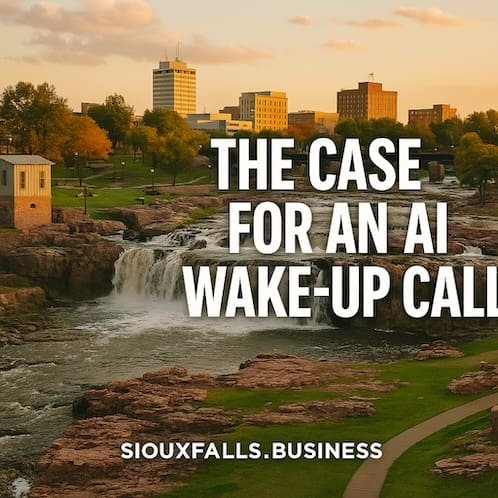AI Insights
Jodi’s Journal: The case for an AI wake-up call

Sept. 7, 2025
I knew the headline for this week’s column — but had no idea what image to put with it.
I had a hunch what could solve my problem, though.
“I am writing a column for SiouxFalls.Business about AI and the need for Sioux Falls businesses to learn to use it,” I typed into ChatGPT.
“The headline is ‘The case for an AI wake-up call.’ I’m not sure what to use as an image. Could you create one that blends both Sioux Falls and this headline?”
This was the first attempt.
It wasn’t what I wanted, though, and it was my fault for not being precise enough in my prompt.
“I should note, I don’t actually want the words used in the image. I want the image to reflect the words,” I typed back. “Your image of Sioux Falls is nice. But can you also incorporate the theme of the headline?”
Here was the next version.
“I like it! Good job,” I told it.
“Thank you! I’m glad you like it,” it replied.”Let me know if you’d like alternate versions, different styles (e.g. more abstract, futuristic, or minimalist), or if you need a web- or print-ready file format. Happy to help however you’d like to use it in the column.”
If you’ve started using ChatGPT in your work life, as I have, this won’t surprise you. If not, well, welcome to the wake-up call.
Generative AI, a type of artificial intelligence that can create new, original content, has evolved rapidly this year. If you are not yet starting to incorporate this into your work flow, it’s time to get going or you’re going to find yourself at a competitive disadvantage.
In my own work world, I’ve already found multiple time-saving and content-enhancing applications for AI. The potential to unlock more is enormous and should benefit both our readers and my business. I feel like I need to figure out how to invest more time specifically in figuring this out, because others in my industries are and will.
The other day, I was working on a story that will run in the next couple of weeks about some proposed projects. The renderings were nicely done, and I asked if an architect should be credited. I was told the intern had created them using AI. Welcome to the first of many professions that will be disrupted.
The more obvious application is in writing, where I would caution you that while much of the copy generated by AI might “sound good,” it leans toward generic in some cases and over the top in others. I’m pretty good at figuring out when it’s being used — and there are plenty of detectors that confirm my suspicions. That said, the technology constantly is improving and the more it “learns” your personal communication style, the better it can assist.
This point in time reminds me a bit of the birth of widespread Internet service.
In 1995, hardly any business had a website.
By 2005, all the early adopters had one and most businesses of any scale had one.
By 2010, if you didn’t have one, you were considered behind the times and missing out of business because of it.
Fifteen years to go from new technology to standard. And I think AI adoption by its very nature will go faster — if we can keep up.
About a year ago, the Prairie Family Business Association surveyed 160 regional family businesses about a variety of topics, including for the first time AI.
Thirteen percent of firms had implemented AI into their business practices, and only 18 percent of companies felt they had the necessary skills to do so. When asked whether AI can provide a higher return on investment, 58 percent indicated “neither agree nor disagree.”
Only 11 percent of family businesses agreed that top management promoted AI as a strategic priority, and 17 percent said they agreed that their company has AI skills.
That’s concerning for future sustainability. I understand it’s hard to know where to start or to immediately see applications for your business, but it can be as easy as creating a free account and exploring its capabilities. I’m also definitely starting to see the opportunities for entrepreneurially-minded people and organizations that can become experts in helping others navigate the changing landscape ahead.
At the same point, as a community, we need to recognize the very real threat AI seems to pose to certain segments of the economy. That next recession many of us have been anticipating for years could be driven by job loss in traditional “white-collar” roles eliminated or scaled back because of what AI can do faster, cheaper and more accurately.
I also see a very real threat to human intellect in this. Much as the Industrial Revolution led to people being less physically active, it stands to reason the looming AI revolution could do the same for us mentally. The better AI gets at forming thoughts for us, the less some learn to think, analyze and evaluate for themselves? I could see it. The ones who will succeed will keep pace with the technology and leverage it effectively. Or they will gravitate toward occupations that are more difficult to supplant with automation and AI. Communities should position themselves to do the same.
Remember what ChatGPT asked me about the Sioux Falls image? Would I like to see a more futuristic one? Here it is.
A bit dark or even sinister, don’t you think? But given the context, maybe fitting. That said, I had to ask if it really thought Sioux Falls would see buildings as tall as the ones in the image.
ChatGPT responded with an analysis of current tall buildings in Sioux Falls, a reference to the Downtown 2035 plan, a note that the city was working on its Shape Sioux Falls 2050 comprehensive plan and a conclusion that Sioux Falls “is still poised to evolve with mid-rise, mixed-use developments—likely in the 4–10 story range—rather than transforming into a metropolis of towering skyscrapers.”
The good news for me is that three of the five sources used for this conclusion came from SiouxFalls.Business. At least in media, I appear to add value in providing information deemed credible enough for ChatGPT to use — not like I’m getting paid for it, of course, but that’s another issue.
We will start to do more coverage of AI — the businesses that are using it and the issues that come along with it. I think it needs to be part of our role as a business media organization to help raise awareness of this paradigm-shifting technology. Hopefully the stories will be read — if not as soon as they’re published, then as soon as the inevitable AI wake-up call arrives for you and your business.
AI Insights
Pittsburgh’s AI summit: five key takeaways

The push for artificial intelligence-related investments in Western Pennsylvania continued Thursday with a second conference that brought together business leaders and elected officials.
Not in attendance this time was President Donald Trump, who headlined a July 15 celebration of AI opportunity at Carnegie Mellon University.
This time Gov. Josh Shapiro, U.S. Sen. David McCormick and others converged in Bakery Square in Larimer to emphasize emerging public-private initiatives in anticipation of growing data center development and other artificial intelligence-related infrastructure including power plants.
Here’s what speakers and attendees at the summit were saying.
AI is not a fad
As regional leaders and business investors consider their options, BNY Mellon’s CEO Robin Vince cautioned against not taking AI seriously.
“The way to get left behind in the next 10 years is to not care about AI,” Vince said
“AI is transforming everything,” said Selin Song during Thursday’s event. As president of Google Customer Solutions, Song said that the company’s recent investment of $25 million across the Pennsylvania-Jersey-Maryland grid will help give AI training access to the more than 1 million small businesses in the state.
Google isn’t the only game in town
Shapiro noted that Amazon recently announced plans to spend at least $20 billion to establish multiple high-tech cloud computing and AI innovation campuses across the state.
“This is a generational change,” Shapiro said, calling it the largest private sector investment in Pennsylvania’s history. “This is our next chapter in innovative growth. It all fits together. This new investment is beyond data center 1.0 that we saw in Virginia.”
Fracking concerns elevated
With all of the plans for new power-hungry data centers, some are concerned that the AI push will create more environmental destruction. Outside the summit, Food & Water Watch Pennsylvania cautioned that the interest in AI development is a “Trojan horse” for more natural gas fracking. Amid President Donald Trump’s attempts to dismantle wind and solar power, alternatives to natural gas appear limited.
Nuclear ready for its moment
But one possible alternative was raised at the AI conference by Westinghouse Electric Company’s interim CEO Dan Summer.
The Pittsburgh-headquartered organization is leading a renewed interest in nuclear energy with plans to build a number of its AP 1000 reactors to help match energy needs and capabilities.
Summer said that the company is partnering with Google, allowing them to leverage Google’s AI capabilities “with our nuclear operations to construct new nuclear here.”
China vs. ‘heroes’
Underlying much of the AI activity: concerns with China’s work in this field
“With its vast resources, enormous capital, energy, workforce, the Chinese government is leveraging its resources to beat the United States in AI development,” said Nazak Nikakhtar, a national security and international trade attorney who chaired one of the panels Thursday.

Speaking to EQT’s CEO Toby Rice and Groq executive Ian Andrews, Nikakhtar outlined some of the challenges she saw in U.S. development of AI technology compared to China.
“We are attempting to leverage, now, our own resources, albeit in some respects much more limited vis-a-vis what China has, to accelerate AI leadership here in the United States and beat China,” she said. “But we’re somewhat constrained by the resources we have, by our population, by workforce, capital.”
Rice said in response that the natural resources his company is extracting will help power the country’s ability to compete with China.
Rice drew a link between the 9/11 terror attacks 24 years earlier and the “urgency” of competing with China in AI.
“People are looking to take down American economies,” Rice said. “And we have heroes. Never forget. And I do believe that us winning this race against China in AI is going to be one of the most heroic things we’re going to do.”
Eric Jankiewicz is PublicSource’s economic development reporter and can be reached at ericj@publicsource.org or on Twitter @ericjankiewicz.
AI Insights
Commanders vs. Packers props, SportsLine Machine Learning Model AI picks, bets: Jordan Love Over 223.5 yards

The NFL Week 2 schedule gets underway with a Thursday Night Football matchup between NFC playoff teams from a year ago. The Washington Commanders battle the Green Bay Packers beginning at 8:15 p.m. ET from Lambeau Field. Second-year quarterback Jayden Daniels led the Commanders to a 21-6 opening-day win over the New York Giants, completing 19 of 30 passes for 233 yards and one touchdown. Jordan Love, meanwhile, helped propel the Packers to a dominating 27-13 win over the Detroit Lions in Week 1. He completed 16 of 22 passes for 188 yards and two touchdowns.
NFL prop bettors will likely target the two young quarterbacks with NFL prop picks, in addition to proven playmakers like Deebo Samuel, Romeo Doubs and Zach Ertz. Green Bay’s Jayden Reed has been dealing with a foot injury, but still managed to haul in a touchdown pass in the opener, while Austin Ekeler (shoulder) does not carry an injury designation for TNF. The Packers enter as a 3-point favorite with Green Bay at -172 on the money line, while the over/under is 49 points. Before betting any Commanders vs. Packers props for Thursday Night Football, you need to see the Commanders vs. Packers prop predictions powered by SportsLine’s Machine Learning Model AI.
Built using cutting-edge artificial intelligence and machine learning techniques by SportsLine’s Data Science team, AI Predictions and AI Ratings are generated for each player prop.
For Packers vs. Commanders NFL betting on Monday Night Football, the Machine Learning Model has evaluated the NFL player prop odds and provided Commanders vs. Packers prop picks. You can only see the Machine Learning Model player prop predictions for Washington vs. Green Bay here.
Top NFL player prop bets for Commanders vs. Packers
After analyzing the Commanders vs. Packers props and examining the dozens of NFL player prop markets, the SportsLine’s Machine Learning Model says Packers quarterback Love goes Over 223.5 passing yards (-112 at FanDuel). Love passed for 224 or more yards in eight games a year ago, despite an injury-filled season. In 15 regular-season games in 2024, he completed 63.1% of his passes for 3,389 yards and 25 touchdowns with 11 interceptions. Additionally, Washington allowed an average of 240.3 passing yards per game on the road last season.
In a 30-13 win over the Seattle Seahawks on Dec. 15, he completed 20 of 27 passes for 229 yards and two touchdowns. Love completed 21 of 28 passes for 274 yards and two scores in a 30-17 victory over the Miami Dolphins on Nov. 28. The model projects Love to pass for 259.5 yards, giving this prop bet a 4.5 rating out of 5. See more NFL props here, and new users can also target the FanDuel promo code, which offers new users $300 in bonus bets if their first $5 bet wins:
How to make NFL player prop bets for Washington vs. Green Bay
In addition, the SportsLine Machine Learning Model says another star sails past his total and has nine additional NFL props that are rated four stars or better. You need to see the Machine Learning Model analysis before making any Commanders vs. Packers prop bets for Thursday Night Football.
Which Commanders vs. Packers prop bets should you target for Thursday Night Football? Visit SportsLine now to see the top Commanders vs. Packers props, all from the SportsLine Machine Learning Model.
AI Insights
Adobe Says Its AI Sales Are Coming in Strong. But Will It Lift the Stock?

Adobe (ADBE) just reported record quarterly revenue driven by artificial intelligence gains. Will it revive confidence in the stock?
The creative software giant late Thursday posted adjusted earnings per share of $5.31 on revenue that jumped 11% year-over-year to a record $5.99 billion in the fiscal third quarter, above analysts’ estimates compiled by Visible Alpha, as AI revenues topped company targets.
CEO Shantanu Narayen said that with the third-quarter’s revenue driven by AI, Adobe has already surpassed its “AI-first” revenue goals for the year, leading the company to boost its outlook. The company said it now anticipates full-year adjusted earnings of $20.80 to $20.85 per share and revenue of $23.65 billion to $23.7 billion, up from adjusted earnings of $20.50 to $20.70 on revenue of $23.50 billion to $23.6 billion previously.
Shares of Adobe were recently rising in late trading. But they’ve had a tough year so far, with the stock down more than 20% for 2025 through Thursday’s close amid worries about the company’s AI progress and growing competition.
Wall Street is optimistic. The shares finished Thursday a bit below $351, and the mean price target as tracked by Visible Alpha, above $461, represents a more than 30% premium. Most of the analysts tracking the stock have “buy” ratings.
But even that target represents a degree of caution in the context of recent highs. The shares were above $600 in February 2024.
-

 Business2 weeks ago
Business2 weeks agoThe Guardian view on Trump and the Fed: independence is no substitute for accountability | Editorial
-
Tools & Platforms1 month ago
Building Trust in Military AI Starts with Opening the Black Box – War on the Rocks
-

 Ethics & Policy2 months ago
Ethics & Policy2 months agoSDAIA Supports Saudi Arabia’s Leadership in Shaping Global AI Ethics, Policy, and Research – وكالة الأنباء السعودية
-

 Events & Conferences4 months ago
Events & Conferences4 months agoJourney to 1000 models: Scaling Instagram’s recommendation system
-

 Jobs & Careers2 months ago
Jobs & Careers2 months agoMumbai-based Perplexity Alternative Has 60k+ Users Without Funding
-

 Podcasts & Talks2 months ago
Podcasts & Talks2 months agoHappy 4th of July! 🎆 Made with Veo 3 in Gemini
-

 Education2 months ago
Education2 months agoMacron says UK and France have duty to tackle illegal migration ‘with humanity, solidarity and firmness’ – UK politics live | Politics
-

 Education2 months ago
Education2 months agoVEX Robotics launches AI-powered classroom robotics system
-

 Funding & Business2 months ago
Funding & Business2 months agoKayak and Expedia race to build AI travel agents that turn social posts into itineraries
-

 Podcasts & Talks2 months ago
Podcasts & Talks2 months agoOpenAI 🤝 @teamganassi



